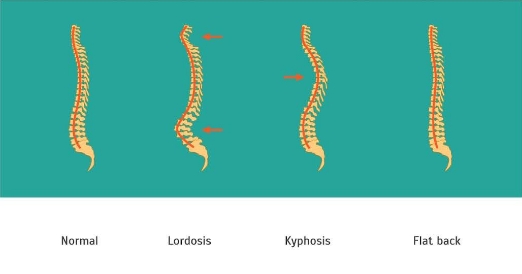Scoliosis is a condition characterized by an increase in the side-to-side curve of the spine exceeding 10 degrees, as measured using the Cobb angle test, often accompanied by increased rotation leading to a distinct rib hump.
The spine typically possesses front-to-back curves, with specific designations: lordosis in the lower back and neck, and kyphosis in the thorax.
Click here for courses for people with Scoliosis
Understanding Scoliosis:
Scoliosis can manifest as a single primary curve, known as C-shaped scoliosis, or as two curves, forming an S-shape. The nomenclature of these curves is based on the side of the apex; for instance, a curve with the apex on the right side is termed dextroscoliosis, while on the left side, it’s termed levoscoliosis.



While mild cases of scoliosis may not induce pain and can be managed through spinal mobility and strength exercises, rapid progression during adolescence or significant curvature in adulthood may necessitate bracing or surgical intervention.
Idiopathic scoliosis:
This is the most common type. “Idiopathic” means the cause is unknown. There is some research suggests a genetic (hereditary) link. It is more common in girls than boys, with a ratio of 10:1. Idiopathic scoliosis accounts for 80% of scoliosis cases and is usually a reverse S-shape curve.
Neuromuscular scoliosis:
This happens with conditions like, cerebral palsy, spina bifida or muscular dystrophy. The nerves that control the muscles also effect the way the spine develops.
Congenital scoliosis:
Means that a person is born with it. This commonly happens with the vertebra, the bones that make up the spine, don’t separate properly as the baby develops which causes scoliosis.
Degenerative Scoliosis:
This type of scoliosis happens to adults for a variety of reasons. It can be the natural age related progression of an idiopathic scoliosis. It can be due to an injury such as a fracture to a vertebrae making them more ‘wedge shaped’. It can also happen due to wear and tear, microtraumas and repetitive activities that push the spine into a certain position. This becomes more common as the bones weaken due to osteoporosis and the joints change with arthritis. This type of scoliosis commonly affects the lumbar spine.
Scoliosis affects an estimated 2% of people around the world.
Click here for courses for people with Scoliosis
Scoliosis in children or teens doesn’t normally cause symptoms but the signs include:
Some high schools test for scoliosis using a simple test called the Adams test. This involves the person being tested bending forward and a health provider looking for a rib hump. However the test is not very accurate at picking up on smaller curves that are less than 20 degrees.
A healthcare provider such as a doctor, chiropractor, osteopath or physiotherapist will diagnose scoliosis after a physical exam and the Adams test. You can do the Adams test at home to find out what type of scoliosis you have by clicking the link HERE.
From there they might request an x-ray which will allow them to measure the curve angle, also known as the Cobb Angle. Ideally the x-ray should be a full standing x-ray that includes the hips and the lower part of the skull. It should be taken from the front to back (A/P angle) and the side angle. This way the specialist can check for birth abnormalities, leg length and any other structural abnormalities that might impact a scoliosis. If necessary they may request further tests like an MRI (magnetic resonance imaging) or CT (computed tomography) scan.
A healthcare provider will measure the curve of your spine in degrees (Cobb Angle). They’ll rate the severity based on the degree of the curve:
It is also possible to measure the rotation using a device called a scoliometer. This cab be done at home by a caregiver and now there are simple apps to be used with a smartphone that can help.
Scoliosis that is present in children and teens should be monitored using standing x-rays to make sure it doesn’t progress rapidly. If it does, most parents are given the choice of bracing and if the curve goes over a certain number of degrees (surgeon and country dependent) then surgery.
However most are not offered the option of adding in scoliosis specific exercises as well. The reasons for that are many, but the main one is simply a lack of knowledge on behalf of the primary care physicians and surgeons.
Secondly if a child is skeletally young, meaning they have a lot of growing to do and they have a high curve then scoliosis exercises might not be effective at reversing the curve. This means that some doctors think that scoliosis exercises don’t work.
This is not the case. With children and teens who’s curves are not progressing rapidly doing specific scoliosis exercises can slow down, stop and even reverse the progression of scoliosis.
The same is true for adults. However with adults the curve tends to progress after the age of 50 so curve reversal may not be possible in all cases but cessation of curve progression is.
You’re more likely to develop scoliosis if someone in your biological family has the condition. But not all cases of scoliosis are genetic.